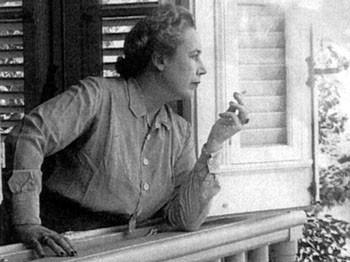Havana Nights: Lydia Cabera
Spirit Quest
Smithsonian’s new CDs exorcise Cuban ghosts
By Greg Cahill
OVER THE YEARS, Americans have plundered Cuba for everything from sugar cane to yuppie music, world-class cigars to cheap sex. But few take the time to appreciate the subtleties of this complex society. A pair of newly released CDs on the Smithsonian/Folkways label explore the 19th-century religious roots of Cuban culture with its deep ties to the spiritual and social traditions of West Africa.
The two volumes–Havana, Cuba, ca. 1957: Rhythms and Songs for the Orishas and Havana Cuba, ca. 1957: Afro-Cuban Sacred Music from the Countryside–are culled from an obscure 14-album series recorded in the field and collected by revered ethnographer and folklorist Lydia Cabera and photographer Josefina Tarafa. The original albums were pressed for a small label and privately issued. The two new discs–which include rare bembe lukumi ritual drumming of a bygone era in the rural province of Matanzas, as well as ceremonial urban rhythms from Havana–reveal some of the most significant threads of Afro-Cuban music history and underscore Cuba’s prominence in the web of Afro-Atlantic music in Brazil, Trinidad, Miami, New York, and elsewhere.
For her part, Cabera was no stranger to Cuban culture. Born in 1900 to a prominent Havana family, she moved to Paris in 1927–the same year that American entertainer Josephine Baker became the toast of Paris, sparking a huge interest in black culture–to study painting at the Ecole des Beaux Arts. During her schooling, Cabera began to delve into the art and religions of India and Japan, which reawakened her interest in Afro-Cuban subjects. Cabera later said that she discovered Cuba on the banks of the Seine.
It was a period that incubated Cabera’s first published work, Cuentos Negros de Cuba (Black Tales of Cuba), originally written to entertain a friend, a Venezuelan novelist convalescing in a Swiss sanitarium.
In 1938, Cabera returned to Cuba, restoring a dilapidated Spanish colonial mansion. During the next few years, she expanded her studies of the island’s African heritage. That research culminated in 1954 with the publication of Cabera’s masterwork, El Monte, with photography by Tarafa.
Cabera’s contributions as a musicologist are perhaps the least-known aspect of her celebrated life’s work. With Tarafa’s portable tape recorder and the assistance of two sound engineers, Cabera recorded secretive Santeria priests, many of whom were descendants of Nigerian Yoruba slaves, evoking orishas (or spirits) through ceremonial songs that serve today as a window on life in the 19th-century sugar mills and slave plantations that peppered the landscape.
The languid chants, the clattering rhythm sticks, the pulsing drums–these are songs that salute the powerful Shango (king of Oyo Yoruba), pray for protection from the scourge of smallpox, or honor the otherwordly protectors of the land.
For those serious about searching for the roots of Afro-Cuban music, Cabera is the ideal guide on that armchair spirit quest.
Photograph by John Cohen
Spin du Jour
Various Artists
There Is No Eye: Music for Photographs (Smithsonian/Folkways)
He’s a renaissance man. Musician, filmmaker, sound engineer, and photographer John Cohen (a member of the Grammy-nominated old-timey folk ensemble the New Lost City Ramblers) aimed his camera lens on some of the pivotal folk, bluegrass, blues, and beat figures of the ’60s. Set for a Nov. 6 release, this companion CD to the newly published book “There Is No Eye” (PowerHouse Books), includes a smartly packaged 32-page booklet of photos and previously unreleased tracks by Bob Dylan and the Rev. Gary Davis, as well as classic material by Elizabeth Cotton, Bill Monroe, Doc Watson, Muddy Waters, Woody Guthrie, and many others. At a time when interest in American roots music is running high–thanks to the smashing success of the “O Brother, Where Art Thou?” soundtrack and the buzz on the upcoming multi-episode PBS documentary series on roots music–Cohen’s work captures the passing of the torch from backwoods authenticity to traditional urban folk music. A nice addition to any serious folk- and roots-music collector’s library. (GC)
From the October 25-31, 2001 issue of the Northern California Bohemian.











